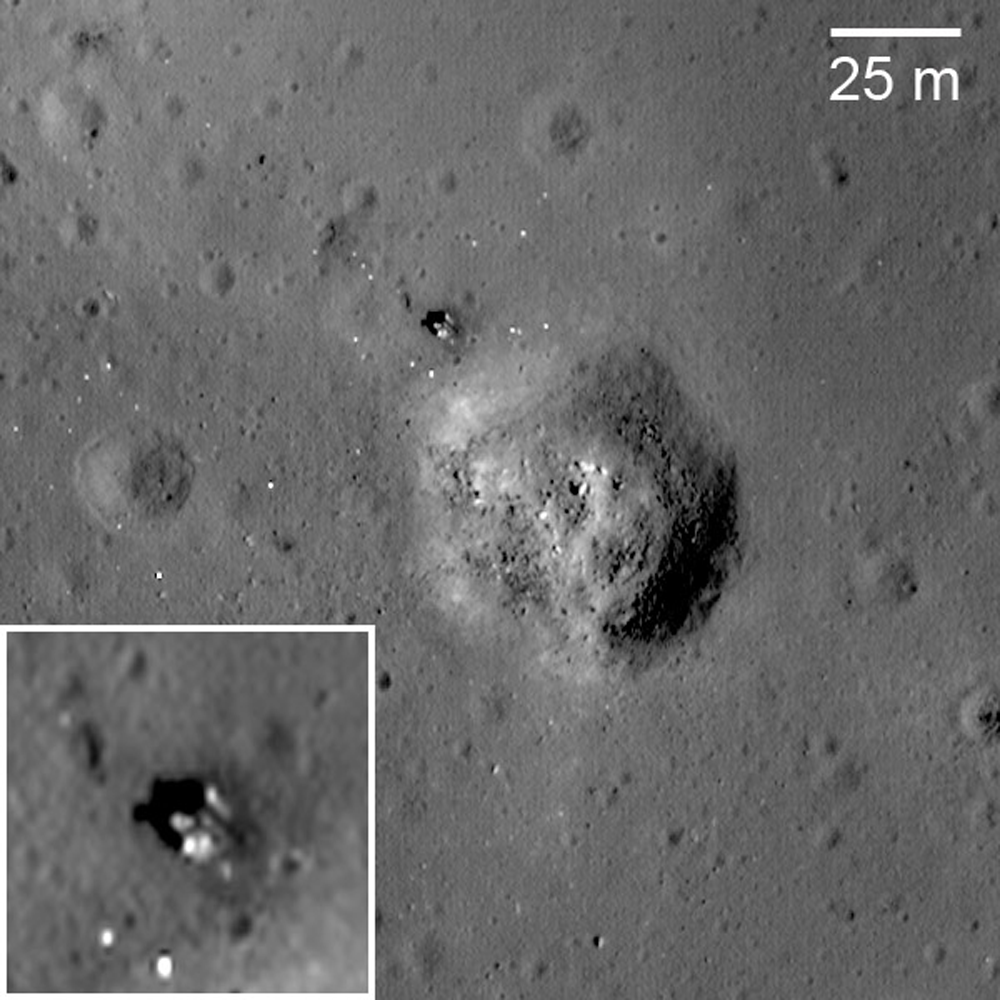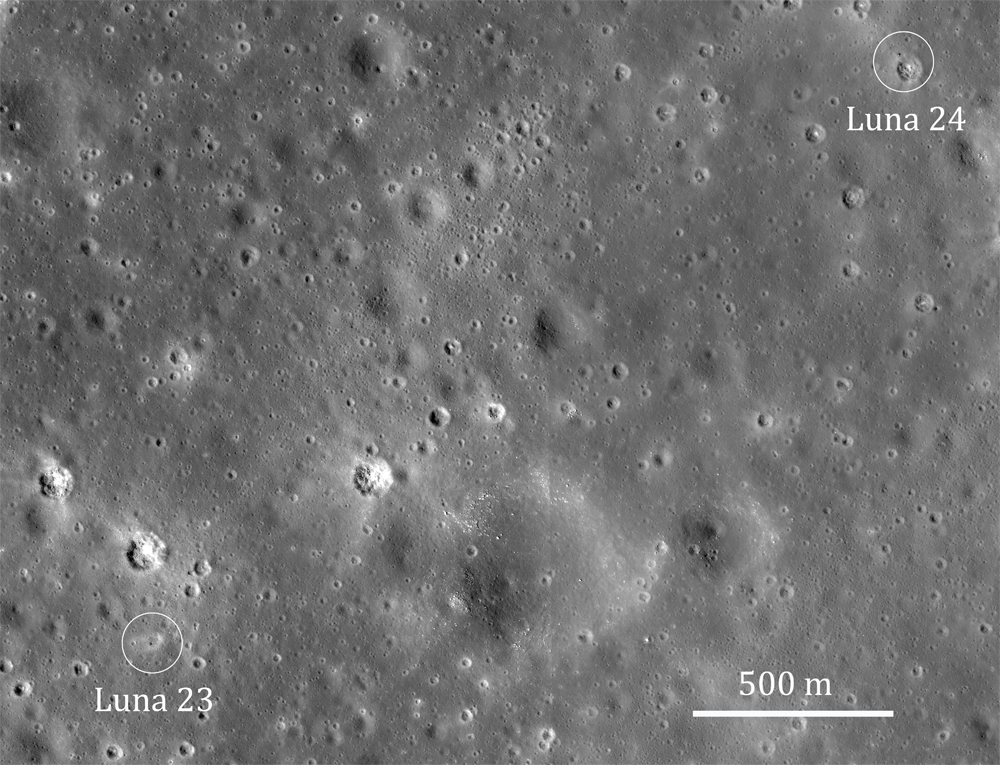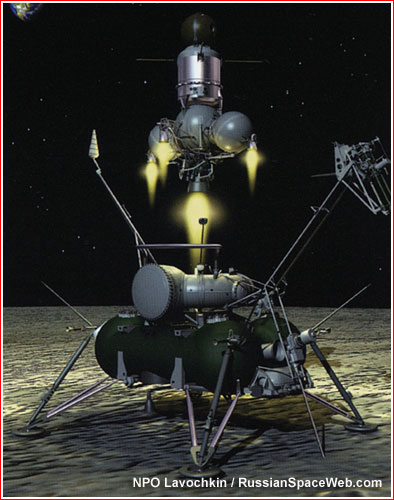
Three Soviet missions (Luna 16, Luna 20, and Luna 24) successfully collected and returned pieces of the lunar surface. Before the successful Luna 24 sample return mission in August 1976, Luna 23 was sent two years earlier (November 1974) to nearly the same location in Mare Crisium, but was unsuccessful.
Luna 24 landed in Mare Crisium on 18 August 1976 to complete the unfinished mission of Luna 23. The landing sites of Luna 23 and 24 are only 2.3 km apart. The region of Mare Crisium where they landed is a typical smooth mare surface with little relief in the immediate vicinity. There are numerous secondary craters scattered across the region, and Luna 24 landed on the edge of one of these. The secondary craters are the result of an impact to the northeast of the landing site, perhaps from the crater Giordano Bruno.
Because the precise locations of the various Soviet robotic landing sites were previously unknown to scientists and engineers, finding the spacecraft in LROC NAC images is a high priority. By locating the spacecraft, we gain an understanding of the geologic context of the rock fragments and soils returned by Lunas 16, 20, and 24. Geologic context allows scientists to place the rock fragments and soils into the "bigger picture" within our current understanding of lunar geology, geochemistry, and geologic history. Many of the robotic spacecraft from various nations have been found already in LROC images, but there are a few remaining spacecraft with unknown locations including the early Soviet landers, Luna 9 and 13.
The Luna sample return spacecraft consisted of three flight elements: descent stage, ascent stage, and Earth-return capsule. The entire suite was landed on the surface, and the sample was acquired and placed in the Earth-return capsule. Then, the ascent stage, carrying the Earth-return capsule, was launched to return to Earth. The descent stage of the Luna spacecraft was left on the surface, which is observed in the LROC NAC images of the Luna 16, 20, and 24 landing sites. In the case of Luna 23, the entire spacecraft is still on the surface because it was damaged during landing and was unable to successfully operate and return a regolith sample to Earth.
Unfortunately, Luna 23 experienced a malfunction and hit the surface at a very high velocity. Contact was maintained between Earth and the spacecraft after landing, but a sample could not be acquired. At the time, the cause of the failure was not known, but it seemed probable that the whole spacecraft tipped over upon landing at an unexpectedly high velocity. Indeed, the high resolution LROC NAC image (below) shows the spacecraft lying on its side!
Luna 24 landed on Mare Crisium on 18 August 1976. The launch occurred several days earlier on 9 August from the Baikonur Cosmodrome using a four-stage Proton rocket. The vehicle arrived at the Moon on 13 August and spent five days in orbit before descending to the surface. After less than 24 hours, the ascent stage fired, sending the sample back toward the Earth. The spacecraft returned a total of 170 g (0.375 pounds) of regolith to the Earth on 22 August. Today's Featured Image here is the highest resolution observation of Luna 24 acquired by LROC, acquired from an altitude of 29 km above the surface, on orbit 10904.
It is hard not to notice all the bright spots around the Luna 24 descent stage. Are they boulders? Most likely, the small (pixel sized) bright dots are pieces of insulation blankets blown off the descent stage when the ascent stage blasted off to send the sample on its way to Earth. If you look closely you can find this type of debris up to a kilometer away from Luna 24! These bright spots are not present around Luna 23 because there was no blast effect from the ascent stage.
The returned Luna 24 sample surprised scientists as it had unexpected characteristics based on the understanding of Mare Crisium geology at the time. Most importantly, the titanium content and the maturity (or the amount of time the sample was exposed to the space environment) of the sample material were different than anticipated. But how could this be? Based on the geologic context of the lander, the reason for the difference may now be understood. With the precise location of the landing site now known, the LROC images show that the mission sampled impact ejecta from a nearby 64-meter diameter crater. That crater has excavated below the surface bringing up material from deeper lava flows that had not been previously exposed to the space environment. Thus, the Luna 24 sample may not represent nearby Mare Crisium surface materials observed using remote sensing techniques, but rather the subsurface which was only exposed to the space environment for the relatively short time. It’s amazing what geologic context can tell you!
Explore the surroundings near the Luna 24 spacecraft on your own!
Review earlier LROC Featured Images highlighting Luna 16, Luna 20 and Luna 24, and the two Soviet rovers Lunokhod 1 and Lunokhod 2.
Published by Jeff Plescia on 16 March 2012


